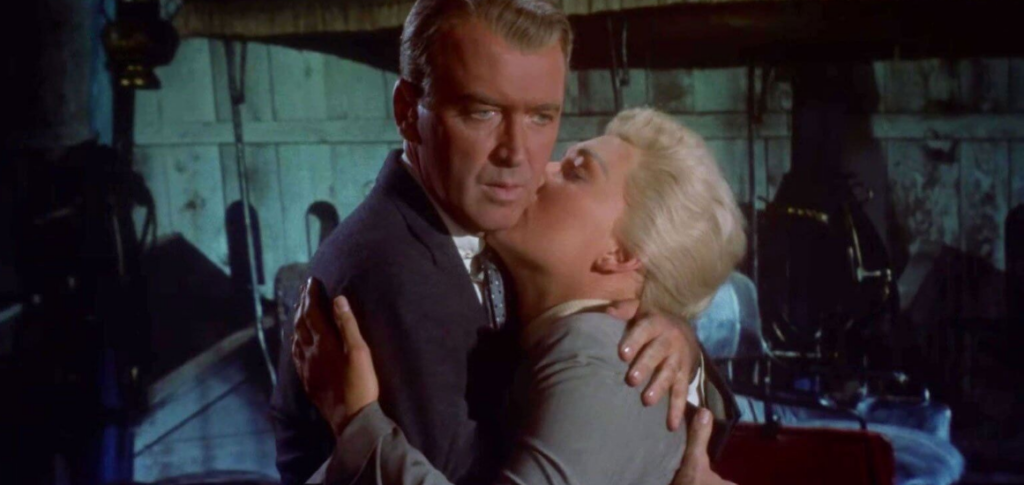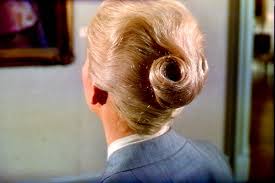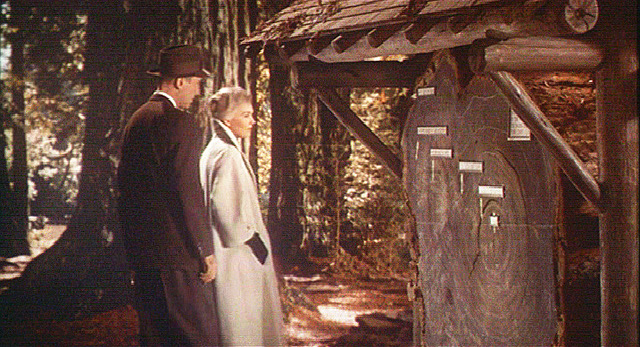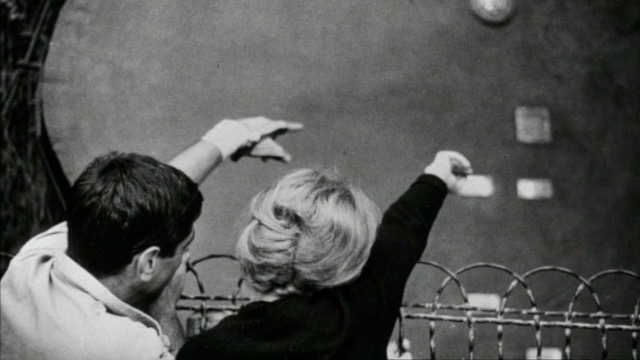| Allison Vincent |

Vertigo plays on phenomenal 70mm at the Heights Theater from Wednesday, April 23rd, through Thursday, April 24th, as part of our collaboration on the Hitchcock Festival. For tickets, showtimes, and other series information, visit trylon.org.
I do not identify as a time travel girly. Movies where the laws of time and space are bent need strong foundations for me to enjoy them, otherwise I find myself inundated with intrusive thoughts about logic, the “rules of the universe” (those generated by the plotline, not the Stephen Hawking kind), and the gnawing inevitability that something is going to go wrong. Truth be told, they stress me out. I was generally cool with time travel until I read Ray Bradbury’s “The Sound of Thunder” in middle school. The concept of “the butterfly effect” broke my little type-A/Virgo/Enneagram 8 brain. It’s too much responsibility! It’s the same reason I ardently respect the signage in antique shops and museums: Look, but don’t touch. I don’t want to disturb the past for fear of ruining the future. But, if the plot of the movie has a firm and intriguing heartbeat or is goofy enough to get me to lower my guard, I’m always willing to forgive a little arrhythmia here and there. Charming portrayals of time manipulation a la Groundhog Day or Run, Lola, Run, get an immediate pass. Films with enough narrative juice to get me over the hump of the actual time travel such as Time After Time or Interstellar allow me to fall into the movie, but, Jesus Christ, that planet where every hour is equivalent to seven years on Earth? AreYouFuckingKiddingMeRightNow?!

I have not watched Interstellar since I first saw it in theaters, despite really liking it!
RIP Rom.
My very favorite method of time manipulation is narrative. I love when writers or directors take us through a story in a non-linear way and really make us work for it. Give me the tattooed protagonist from Memento piecing it all together, the moody jumps in time of Pulp Fiction, and our two unreliable narrators of True Detective season 1. Matthew McConaughey’s hillbilly poeticism has become so entrenched in my concept of time, that if I send you a meme of Rust Cole saying this,

…just accept that I am running late and I will get there when I get there.
But in the case of Vertigo, La Jetée, and 12 Monkeys, time is a spiral. I know Vertigo is not a time travel movie, technically, but it sure feels like one. Because I watched these three films in reverse chronological order, I also now always think of them as one. And if you take my narrative exceptionalism into consideration, it kind of checks out.
IF YOU HAVE NOT WATCHED THE CINEMATIC MASTERPIECE VERTIGO, STOP READING RIGHT NOW.
Vertigo is based on the French psychological mystery D’entre les mortes by Boileau-Narcejac, the pen name of writing duo Pierre Boileau and Pierre Ayrand (aka Thomas Narcejac). You can see where some of the name game elements of the film are rooted, I’m sure. In Hitchcock’s film, Jimmy Stewart plays John Ferguson, “Scottie” to his friends, a police detective forced into early retirement early because of an incapacitating fear of heights. The onset of Ferguson’s acrophobia follows a rooftop chase where Ferguson slips and hangs from the side of a building, holding on for dear life. The police officer in pursuit with him turns back to help him up and falls to his death. Ferguson is haunted by guilt as well as staggering, you guessed it, vertigo. That’s enough exposition. The real plot of Vertigo kicks off when an old college chum of Ferguson’s asks him to tail his wife, Madeleine, who has been acting strange. It seems Madeleine may be possessed by the ghost of her great-grandmother, Carlotta Valdes, who committed suicide. As Ferguson follows Madeleine to the art gallery where she stares at Carlotta’s portrait, he sees that her hair is spiraled in the same blonde updo as Carlotta’s. She rents a room in the hotel where Carlotta lived, she visits the cemetery where she puts flowers on Carlotta’s grave, and finally drives to San Francisco Bay, where she dives in and begins to let herself drown, forcing Ferguson to intervene. Ferguson begins not only to believe her, but to fall for her.

After the suicide attempt, Ferguson refuses to let Madeleine be by herself. The two travel to the Muir Woods and marvel at the gigantic redwoods surrounding them. There is a display where a cross-section of one of the felled giants features a historical timeline on the rings. Madeleine/Carlotta runs her finger over the rings, through time until the 1800s, and says, “Somewhere in here I was born, and here I died, and you took no notice.”


The following day, Madeleine recounts a nightmare to Ferguson, who identifies the setting as the Mission San Juan Bautista, and they set out for the old church. Madeleine/Carlotta recounts visages of the past. Ferguson, desperately trying to maintain Madeleine’s sanity, confesses his love for her. She does the same, but then breaks away, dashing up the stairs of the bell tower. Ferguson follows, but his vertigo causes him to freeze midway, and Madeleine/Carlotta plunges to her death.
This is where things get really interesting. Ferguson has a nervous breakdown and is institutionalized for a bit. When he is released, he sees Madeleine everywhere. Echoes of her abound in his waking life. One woman he notices is such a dead ringer for Madeleine that he follows her up to her apartment? And this single woman lets this strange, possibly deranged man in? The 50s were wild, man.
Anyway, to make a long story short, this woman is Judy Barton, but then we learn through a flashback that she has been playing Madeleine/Carlotta for the evil Gavin so he could kill his wife and fake her suicide to claim the life insurance policy on her. Although she is not really Madeleine, she really did fall in love with Ferguson, and he is OBSESSED with her. He essentially turns her back into Madeleine with the help of some very concerned department store clerks and hairstylists. Ferguson even says, “I have to go into the past one last time,” intimating a sense of time travel after he spies Judy’s/Madeleine’s/Carlotta’s necklace and realizes that someone in this identity soup is a fraud. He forces Judy to the Mission again, and, in defiance of his vertigo (yay!), marches her up to the bell tower. She confesses, a nun scares the shit out of everybody, and Judy jumps to her death repeating the scene once more.
Then, the title card just drops.
It is a wild ass ending. The first time I saw it, I was, as the kids say, shook.
Another film nerd across time and space was similarly shaken to his core. Chris Marker became obsessed with Vertigo. The concept of time as a spiral, the bun, the effects, obsessions with the past, repeating but going deeper into the story with every visitation and analysis of a memory unlocked a deep artistic love in Marker. He went on to make La Jetée, the 1962 photo roman, or “photo novel,” created entirely from still, black and white photos, subtle music, and a traditionally depressed French narrator. The story of La Jetée takes place in the post-apocalyptic world of France after WWIII. Human beings live underground, and a group of scientists has developed a form of time travel where they sit the traveler in a hammock and attach what looks like a sanitary napkin with electrical wires sticking out of it over the traveler’s eyes and jettison him through time. Giddy up.
The unnamed hero of our story is able to go back in time successfully because he has such a strong image from childhood of a woman at an airport that he saw as a boy. That image, burned into his memory banks, acts as a kind of totem that enables him to keep his bearings through time without going mad or dying as other test subjects have. Of course, the other event tied to that memory is a man’s death, which is actually his own, that he witnessed as a child. *Mind blown gesture* Time is a spiral, y’all.
Another film nerd across time and space similarly had his mind blown after watching Marker’s film. Terry Gilliam says the editing of La Jetée “is poetry.” His screenwriters, Janet and David Peoples, said that “We never wanted it to be a remake, but we wanted to make an homage to La Jetée, which is still just one of the most extraordinary films ever made.” The result, 12 Monkeys, falls into that so goofy I don’t get bogged down with the details category of time travel movies.
The plot is extremely similar to La Jetée. It is a loving tribute to Marker’s film translated through Gilliam’s bizarro style with plenty of nods and Easter eggs pointing to Hitchcock’s original source material: Dr. Madeleine Stowe’s appearance echoes Kim Novak’s transformation from Judy to Madeline, the love interest’s name is “Madeleine” and she uses “Judy Simmons” as an alias when she and Cole are lambing it, Cole and Stowe go to a Hitchcock marathon and watch the sequoia sequence from Vertigo, etc. For me, the films are just as much a reflection on adaptation and influence as they are on time and memory. It is fascinating to be able to journey down the rabbit hole of another artist’s influence. In La Jetée, Marker warns that “There is no way out of time.” We are composed of everything that has come before, but we also can’t waste our lives living in the past. Cole says it best in 12 Monkeys, “I don’t think the human mind is supposed to exist in two separate, I don’t know what you would call it, dimensions?” Likewise, if we dawdle too long in the past, we may end up stuck there. As with Detective Ferguson and all good storylines, if we’re going to revisit the past, we have to do so to generate something new, not attempt to change it. Every new spiral downward has to dig deeper than the previous one to get us closer to the center of what makes us who we are and where we came from. But, if we dare to venture down in our timelines, we must be prepared to live with the consequences.

Reference
Miller, Jeremy D. “Time Is a Flat Circle.” The Shade Tree Developer, 2 Sept. 2024. Accessed 05 Apr. 2025.
Edited by Olga Tchepikova-Treon

Amazing essay. Love the shout out to Marker. Strangely enough, I saw “Sans Soleil” before seeing Vertigo. And the video essay therein made me love it before I had even viewed it. Zizek also writes about the time hijinks in Vertigo. It’s wild to consider how the past can actually be “changed” by developments which have a retroactive effect on the truth-value propositions that constitute it (I knew then what is impossible to know now). Ferguson is time’s fool, fr fr. And if you love this movie, it’s because you know what it’s like to crash out. We all are afflicted with the necrophilia of memory.